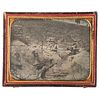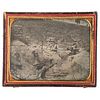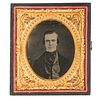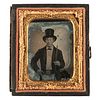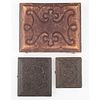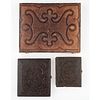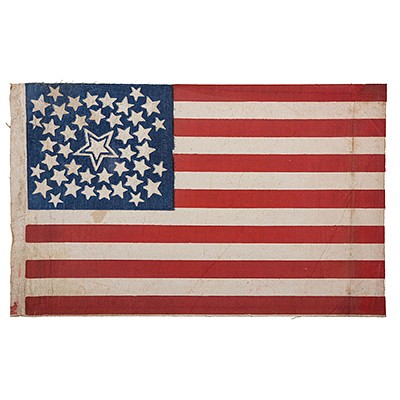Half Plate Daguerreotype of a California Gold Mining Camp, with Portraits of Two Featured Subjects
About Seller
6270 Este Ave.
Cincinnati , OH 45232
United States
With offices in Cincinnati, Cleveland and Denver, Cowan’s holds over 40 auctions each year, with annual sales exceeding $16M. We reach buyers around the globe, and take pride in our reputation for integrity, customer service and great results. A full-service house, Cowan’s Auctions specializes in Am...Read more
Two ways to bid:
- Leave a max absentee bid and the platform will bid on your behalf up to your maximum bid during the live auction.
- Bid live during the auction and your bids will be submitted real-time to the auctioneer.
Bid Increments
| Price | Bid Increment |
|---|---|
| $0 | $25 |
| $500 | $50 |
| $1,000 | $100 |
| $2,000 | $250 |
| $5,000 | $500 |
| $10,000 | $1,000 |
| $20,000 | $2,500 |
| $50,000 | $5,000 |
| $100,000 | $10,000 |
About Auction
Nov 19, 2020
Cowan’s Auctions, a Hindman Company, is pleased to present the November 19 Fall Auction, featuring over 400 lots of historically significant photography, manuscript material, artwork, and other ephemera dating from the 18th through the early 20th century, including the Civil War. Cowan's Auctions dawnie@cowans.com
- Lot Description
Lot of 3 cased images showing a mining operation with two identified subjects, comprising: Half plate daguerreotype of miners at Angel's Camp gold mine in Calaveras County, California. N.p., n.d., [1852]. Housed in leather case. Six men pose for the photographer at their mining site. In a large depression in the foreground, two men stand near a sluice with pitchforks and shovels. The man at center holding a shovel with his hand on his hip is identified as Peaty. Four men stand at the top of a ridge, one, identified as John Comstock (b. ca 1817), stands behind a sluice box tilted on a log frame. Visible on the left edge of the image is a rough-hewn log building. In the background is a wood board building on stilts with a small chimney. Three more board shacks dot the landscape behind the men. Inside of case, behind image an ink inscription reads: "Angles [sic] camp 1852 / John Comstock + Peaty" with an additional clipped note reading: "John / 1852 / Angles [sic] Camp." A 33-year-old John Comstock is listed as "miner" in Calaveras District in the 1850 Census. Two other men, H.M. Kearney and George Hildreth, both of Virginia and both also miners, are listed as sharing a dwelling with Comstock. Sixth plate ruby ambrotype studio portrait of John Comstock, pictured wearing a heathered waistcoat, a dark jacket, and cravat with a tie pin. His cheeks have been very delicately tinted pink. N.p., n.d. ca 1855. In pressed paper case. Clipped note behind image identifies the subject. Ninth plate ambrotype studio portrait of Peaty, pictured wearing a formal black-tie outfit with an overcoat, top hat, and walking stick, perhaps flaunting the wealth gained from gold prospecting N.p., n.d., ca 1855. In pressed paper case. Clipped note behind image identifies the subject. Angels Camp, a Gold Rush Era boomtown in Calaveras County, was founded by Henry Angell, originally from Rhode Island. He served with his brother George under Colonel Frémont during the Mexican War and the two were stationed in Monterey at the end of their enlistment in 1848. Hearing the rumors of gold, they traveled and arrived at Angels Creek where he set up placer mines. Henry would abandon the back-breaking labor of prospecting and open Angels Trading Post at the confluence of Angels and Dry Creek which became enormously prosperous selling general goods and mining supplies at reportedly inflated costs. Angels Creek and its tributaries were rich with gold and by 1849 it was estimated that several thousand miners had set up placers in the area. The placers began to run dry but lode mining began in the 1850s along the Mother Lode, which coursed through Angels Camp. In 1854 an extensive gold-bearing quartz vein was discovered by the Winter brothers prompting a second gold rush. The rich Davis-Winters Lode ran up the main street of Angels Creek to the southern edge of Altaville and would support five major mines at its peak: Stickle, Utica, Lightner, Angels, and Sultana. At their peak in the 1880s and 1890s, over 200 stamps were working round the clock, producing more than $20 million worth of gold, some estimating as high as $30 million.Half plate - Edge of lower left corner is slightly overexposed, else the image is remarkably clear and well developed. Conservator's tape seal suggests the image may have been cleaned. Case is split at the hinge with scuffs. Sixth plate - slight loss to emulsion at upper right edge not affecting the image. Ninth plate - image oxidized at edges, chip to upper right corner of protecting glass (not the ambrotype itself), case hinge split.
Condition
- Shipping Info
-
Buyers are required to pay for all packing, shipping and insurance charges. Overseas duty charges are the responsibility of the successful Bidder. Be aware that for larger and/or valuable items, shipping charges can be substantial. - If there is no shipping amount on listed your invoice, you will need to make arrangements to pick up or ship your purchase through an alternative shipping company. Our shipping department can be contacted at 513.871.1670 (ext. 219) or email shipping@cowans.com. - Shipping charges include insurance for your order while in transit. If you have private insurance we will adjust your charge to include only packing and shipping. - Please allow 14 – 21 days after payment to package and ship your purchase as carefully as possible.
-
- Buyer's Premium



 EUR
EUR CAD
CAD AUD
AUD GBP
GBP MXN
MXN HKD
HKD CNY
CNY MYR
MYR SEK
SEK SGD
SGD CHF
CHF THB
THB
